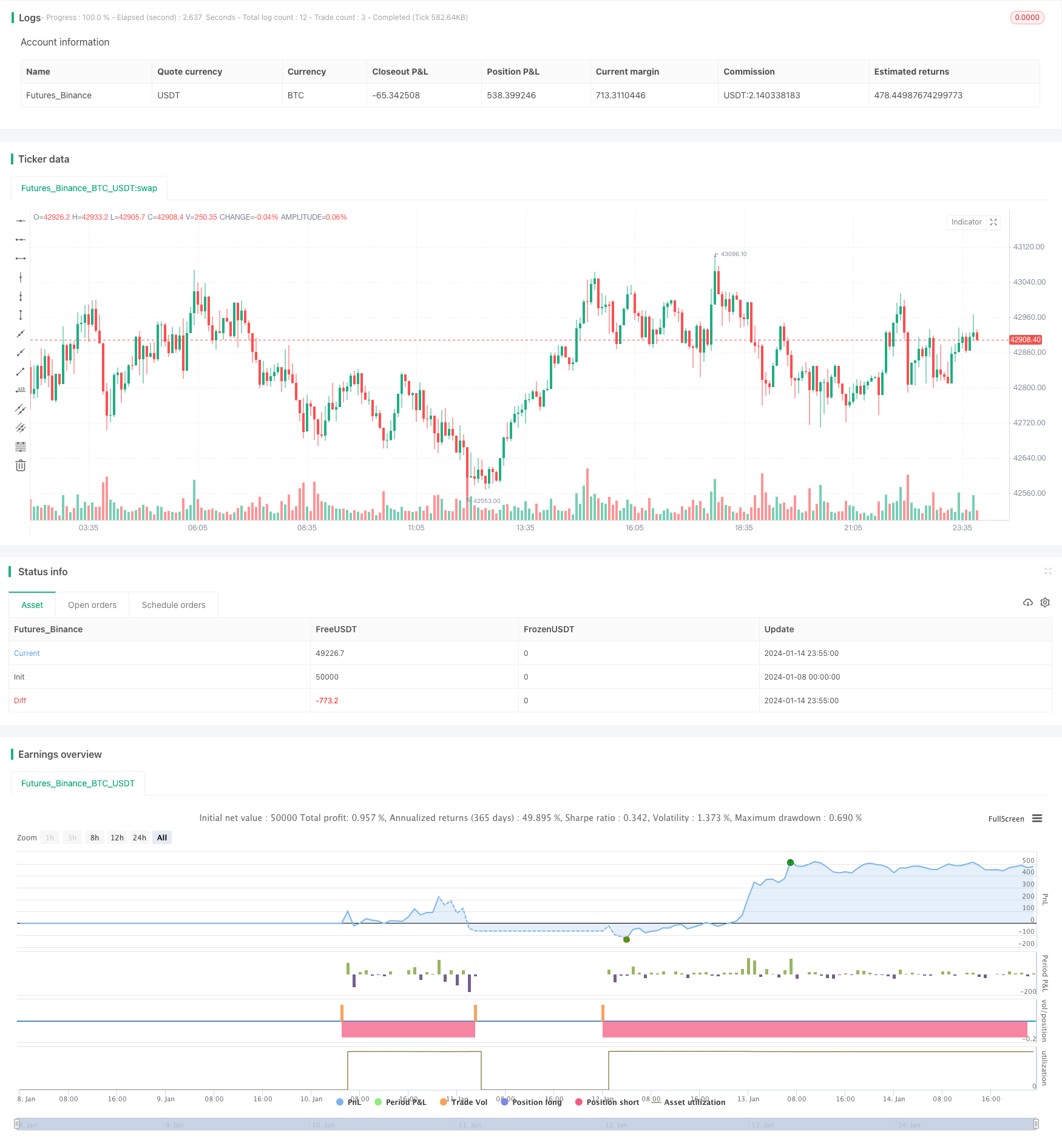アダプティブ・インテリジェント・グリッド・トレーディング・戦略
作者: リン・ハーンチャオチャン,日付: 2024-01-16 14:51:48タグ:

概要
この戦略は,Pine Script v4 で書かれた,TradingView プラットフォームに基づいた適応型インテリジェント・グリッド・トレーディング・戦略である.これは価格チャートに覆われ,購入・販売信号を生成するために指定された境界内でグリッドを作成する.
戦略の論理
主要 な 特徴
-
ピラミッド作りとマネーマネジメント
- 同じ方向に最大14回追加 (ピラミッド式) を許可する
- ポジションのサイズを管理するために現金ベースの戦略を使用します.
- 初期資本は,シミュレーション目的で100米ドルと設定されています.
- 取引ごとに0.1%の小小手数料が請求されます.
-
グリッドの境界:
- ユーザは,自動計算された境界を使用するか,グリッドの上下境界を手動で設定するか選択できます.
- オートバウンドは,最近の高値と低値,または単純な移動平均値 (SMA) から導き出せる.
- ユーザは,限界計算のバックバック期間を定義し,限界を拡大または縮小するために偏差を調整することができます.
-
グリッドライン:
- この戦略では,境界線内のグリッドラインの数が調整可能であり,推奨範囲は3~15です.
- 格子線は上限と下限の間を均等に分けています
戦略の論理
-
入力:
- スクリプトは,価格がグリッドラインを下回り,既存のオーダーがグリッドラインに関連付けられていないときに購入オーダーを置く.
- 各購入オーダーの金額は,初期資本を,現在の価格に調整した電網線数で割った数値に基づいて計算されます.
-
出口:
- 価格がグリッドラインを超えると,次のグリッドライン下位に対応するオープンオーダーがある場合に,セールオーダーが起動する.
-
アダプティブグリッド:
- 自動制限に設定された場合,グリッドは上限と下限を再計算し,それに応じてグリッドを調整することで,市場の状況の変化に適応します.
利点分析
この戦略は,グリッド取引の体系的な性質と効率的な実行を統合している.ピラミディングを許可し,マネーマネジメントを使用することで,リスクを効果的に制御することができる.自動適応グリッドは異なる市場条件に適合する.調整可能なパラメータは,異なる取引スタイルに対応する.
リスク分析
格子を超えた価格ブレイクが深刻な損失を引き起こす可能性があります. リスクを制御するために,パラメータを適切に調整するか,ストップ損失と組み合わせなければなりません. また,過剰な取引は取引コストを増加させます.
オプティマイゼーションの方向性
トレンドフィルターと組み合わせたり,グリッドパラメータを最適化することを検討する.ストップロスは,極端な市場動向によるリスクを防ぐのに役立ちます.
結論
この戦略は,ポジションを管理しながら,体系的にエントリーと出口を生成する.パラメータチューニングを通じて,異なる好みに適応する.グリッド取引のルールベースの性質とトレンド取引の柔軟性を組み合わせ,安定性を維持しながら操作の複雑さを緩和する.
/*backtest
start: 2024-01-08 00:00:00
end: 2024-01-15 00:00:00
period: 5m
basePeriod: 1m
exchanges: [{"eid":"Futures_Binance","currency":"BTC_USDT"}]
*/
//@version=4
strategy("(IK) Grid Script", overlay=true, pyramiding=14, close_entries_rule="ANY", default_qty_type=strategy.cash, initial_capital=100.0, currency="USD", commission_type=strategy.commission.percent, commission_value=0.1)
i_autoBounds = input(group="Grid Bounds", title="Use Auto Bounds?", defval=true, type=input.bool) // calculate upper and lower bound of the grid automatically? This will theorhetically be less profitable, but will certainly require less attention
i_boundSrc = input(group="Grid Bounds", title="(Auto) Bound Source", defval="Hi & Low", options=["Hi & Low", "Average"]) // should bounds of the auto grid be calculated from recent High & Low, or from a Simple Moving Average
i_boundLookback = input(group="Grid Bounds", title="(Auto) Bound Lookback", defval=250, type=input.integer, maxval=500, minval=0) // when calculating auto grid bounds, how far back should we look for a High & Low, or what should the length be of our sma
i_boundDev = input(group="Grid Bounds", title="(Auto) Bound Deviation", defval=0.10, type=input.float, maxval=1, minval=-1) // if sourcing auto bounds from High & Low, this percentage will (positive) widen or (negative) narrow the bound limits. If sourcing from Average, this is the deviation (up and down) from the sma, and CANNOT be negative.
i_upperBound = input(group="Grid Bounds", title="(Manual) Upper Boundry", defval=0.285, type=input.float) // for manual grid bounds only. The upperbound price of your grid
i_lowerBound = input(group="Grid Bounds", title="(Manual) Lower Boundry", defval=0.225, type=input.float) // for manual grid bounds only. The lowerbound price of your grid.
i_gridQty = input(group="Grid Lines", title="Grid Line Quantity", defval=8, maxval=15, minval=3, type=input.integer) // how many grid lines are in your grid
f_getGridBounds(_bs, _bl, _bd, _up) =>
if _bs == "Hi & Low"
_up ? highest(close, _bl) * (1 + _bd) : lowest(close, _bl) * (1 - _bd)
else
avg = sma(close, _bl)
_up ? avg * (1 + _bd) : avg * (1 - _bd)
f_buildGrid(_lb, _gw, _gq) =>
gridArr = array.new_float(0)
for i=0 to _gq-1
array.push(gridArr, _lb+(_gw*i))
gridArr
f_getNearGridLines(_gridArr, _price) =>
arr = array.new_int(3)
for i = 0 to array.size(_gridArr)-1
if array.get(_gridArr, i) > _price
array.set(arr, 0, i == array.size(_gridArr)-1 ? i : i+1)
array.set(arr, 1, i == 0 ? i : i-1)
break
arr
var upperBound = i_autoBounds ? f_getGridBounds(i_boundSrc, i_boundLookback, i_boundDev, true) : i_upperBound // upperbound of our grid
var lowerBound = i_autoBounds ? f_getGridBounds(i_boundSrc, i_boundLookback, i_boundDev, false) : i_lowerBound // lowerbound of our grid
var gridWidth = (upperBound - lowerBound)/(i_gridQty-1) // space between lines in our grid
var gridLineArr = f_buildGrid(lowerBound, gridWidth, i_gridQty) // an array of prices that correspond to our grid lines
var orderArr = array.new_bool(i_gridQty, false) // a boolean array that indicates if there is an open order corresponding to each grid line
var closeLineArr = f_getNearGridLines(gridLineArr, close) // for plotting purposes - an array of 2 indices that correspond to grid lines near price
var nearTopGridLine = array.get(closeLineArr, 0) // for plotting purposes - the index (in our grid line array) of the closest grid line above current price
var nearBotGridLine = array.get(closeLineArr, 1) // for plotting purposes - the index (in our grid line array) of the closest grid line below current price
strategy.initial_capital = 50000
for i = 0 to (array.size(gridLineArr) - 1)
if close < array.get(gridLineArr, i) and not array.get(orderArr, i) and i < (array.size(gridLineArr) - 1)
buyId = i
array.set(orderArr, buyId, true)
strategy.entry(id=tostring(buyId), long=true, qty=(strategy.initial_capital/(i_gridQty-1))/close, comment="#"+tostring(buyId))
if close > array.get(gridLineArr, i) and i != 0
if array.get(orderArr, i-1)
sellId = i-1
array.set(orderArr, sellId, false)
strategy.close(id=tostring(sellId), comment="#"+tostring(sellId))
if i_autoBounds
upperBound := f_getGridBounds(i_boundSrc, i_boundLookback, i_boundDev, true)
lowerBound := f_getGridBounds(i_boundSrc, i_boundLookback, i_boundDev, false)
gridWidth := (upperBound - lowerBound)/(i_gridQty-1)
gridLineArr := f_buildGrid(lowerBound, gridWidth, i_gridQty)
closeLineArr := f_getNearGridLines(gridLineArr, close)
nearTopGridLine := array.get(closeLineArr, 0)
nearBotGridLine := array.get(closeLineArr, 1)
もっと
- 123 逆転点とピボットポイントの組み合わせ戦略
- 移動平均値とストカスティックRSIの組み合わせの取引戦略
- 動的トレンド追跡逆転戦略
- 日々のDCA戦略とEMAの接触
- トレンド強度 バース戦略の確認
- 超トレンド 双動平均戦略
- WaveTrend と DER に 基づく スウィング トレーディング 戦略
- ハル・フィッシャー 適応型 インテリジェント 多要素戦略
- 株式曲線に基づく動的ポジションサイズ戦略
- 双重トレンド追跡戦略
- トレンド追跡逆転戦略
- 価格チャネルブレイク戦略
- SAR 交代期間の取引戦略
- EMA/MAのクロスオーバーオプション取引戦略
- RMI トレンドシンクロ戦略
- マルチタイムフレームMACD移動平均取引戦略
- ADX ダイナミックトレンド戦略
- トレンド フォロー 戦略 ハルスの移動平均値と真の範囲をベースに
- 双重確認量取引戦略
- divergence 戦略の確認